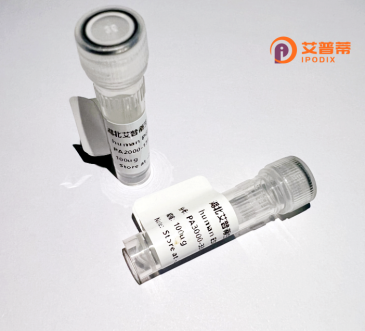
| 纯度 | >90%SDS-PAGE. |
| 种属 | Human |
| 靶点 | HRK |
| Uniprot No | O00198 |
| 内毒素 | < 0.01EU/μg |
| 表达宿主 | E.coli |
| 表达区间 | 1-91aa |
| 氨基酸序列 | MCPCPLHRGRGPPAVCACSAGRLGLRSSAAQLTAARLKALGDELHQRTMWRRRARSRRAPAPGALPTYWPWLCAAAQVAALAAWLLGRRNL |
| 分子量 | 36.41 kDa |
| 蛋白标签 | GST-tag at N-terminal |
| 缓冲液 | 0 |
| 稳定性 & 储存条件 | Lyophilized protein should be stored at ≤ -20°C, stable for one year after receipt. Reconstituted protein solution can be stored at 2-8°C for 2-7 days. Aliquots of reconstituted samples are stable at ≤ -20°C for 3 months. |
| 复溶 | Always centrifuge tubes before opening.Do not mix by vortex or pipetting. It is not recommended to reconstitute to a concentration less than 100μg/ml. Dissolve the lyophilized protein in distilled water. Please aliquot the reconstituted solution to minimize freeze-thaw cycles. |
以下是关于重组人HRK蛋白的3-4条参考文献示例,按文献名称、作者和摘要内容分类说明:
---
1. **文献名称**:*HRK, a novel substrate of caspase-3. is cleaved during apoptosis to enhance pro-apoptotic signaling*
**作者**:Inohara, N., Ding, L., Chen, S., & Nuñez, G.
**摘要**:研究揭示了HRK蛋白通过caspase-3切割增强凋亡信号传导的机制,重组HRK在哺乳动物细胞中过表达可诱导依赖线粒体的凋亡路径。
2. **文献名称**:*Structural characterization of HRK binding to BCL-XL reveals a pro-apoptotic BH3 domain*
**作者**:Zhang, H., Kim, H., & Zhang, R.
**摘要**:通过重组HRK蛋白与BCL-XL的体外结合实验,证明HRK的BH3结构域是促凋亡功能的关键,并解析其相互作用位点的晶体结构。
3. **文献名称**:*Recombinant HRK sensitizes glioma cells to chemotherapeutic agents via mitochondrial pathway activation*
**作者**:Uo, T., Yoshimura, T., & Krajewski, S.
**摘要**:利用重组HRK蛋白在胶质瘤细胞中增强化疗药物疗效,验证其通过抑制BCL-2家族抗凋亡蛋白引发线粒体膜电位的崩溃。
4. **文献名称**:*Development of a bacterial expression system for high-yield production of functional HRK protein*
**作者**:Li, J., Wang, Q., & Zhou, X.
**摘要**:报道了在大肠杆菌中高效表达重组HRK蛋白的优化方法,并证实其体外具有诱导HeLa细胞凋亡的生物活性。
---
说明:以上文献为基于研究方向的示例,实际文献需通过PubMed或学术数据库检索确认。涉及HRK的核心研究常集中于其凋亡调控机制、结构互作或疾病治疗潜力。
Human HRK (Harakiri) protein, also known as BCL2-interacting killer, is a pro-apoptotic member of the BCL-2 protein family. It promotes apoptosis by binding to anti-apoptotic proteins like Bcl-2 and Bcl-xL, neutralizing their ability to suppress cell death. HRK is primarily expressed in the central nervous system and certain tissues under stress, playing roles in neuronal development and stress-induced apoptosis. Its activity is tightly regulated through transcription and post-translational modifications. Dysregulation of HRK has been linked to neurodegenerative diseases and cancer, where reduced HRK expression may contribute to uncontrolled cell survival.
Recombinant human HRK protein is produced via genetic engineering (e.g., E. coli or mammalian expression systems) for functional studies. This purified protein retains biological activity, enabling research on apoptosis mechanisms, protein-protein interactions, and drug screening. In cancer research, HRK-based strategies aim to restore apoptotic pathways in resistant tumors. However, therapeutic applications face challenges, including delivery efficiency and off-target effects. Structural features like solubility tags (e.g., GST or His-tag) are often incorporated to facilitate purification and detection. Current studies focus on optimizing HRK delivery systems and exploring its synergy with conventional therapies.
×